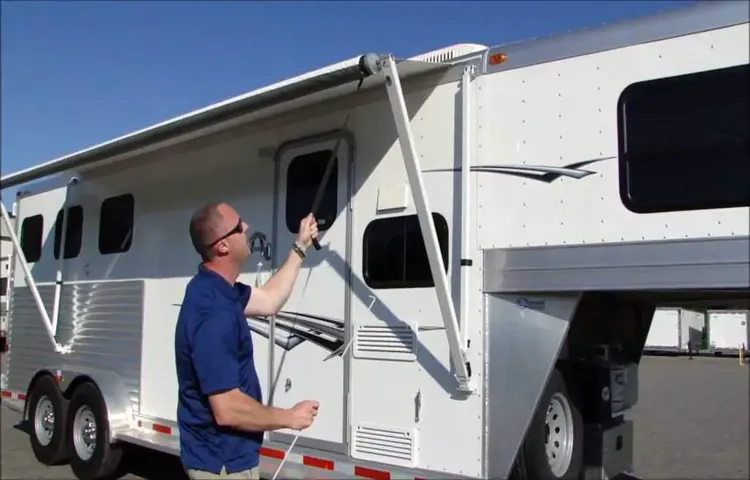Have you ever been sitting outside your RV, enjoying a peaceful afternoon when suddenly, the wind picks up? You watch as your awning begins to flap ominously in the breeze, and you worry about whether it can withstand the gusts. It’s natural to wonder how high of wind an RV awning can handle before it gets damaged. RV awnings provide much-needed shade and protection from the elements while you’re enjoying the great outdoors.
However, they are not designed to withstand extreme weather conditions like strong winds. While every awning is different, most manufacturers recommend retracting the awning when wind speeds reach 15-20 miles per hour. Wind speed is not the only factor to consider when determining if it’s safe to leave your awning out.
The direction and suddenness of the wind can also have an impact on its stability. Sudden gusts or winds coming from an angle can put more stress on the awning, increasing the risk of damage. So, why is it crucial to retract your awning in high winds? Think about it like this: imagine trying to hold a flimsy umbrella in a strong wind.
The force of the wind will place immense pressure on the umbrella, causing it to bend, twist, or even break. The same principle applies to RV awnings. They are not built to withstand the full force of high winds and can easily get damaged if left out.
It’s important to prioritize your safety and the longevity of your RV awning by following the manufacturer’s recommendations. Retracting your awning in high winds will help prevent costly repairs or having to replace the entire awning. In conclusion, while it might be tempting to leave your RV awning out during windy conditions, it’s best to play it safe and retract it.
By doing so, you’ll protect your awning from potential damage and ensure your own peace of mind while enjoying the great outdoors.
Table of Contents
Introduction
Many RV owners wonder just how high of wind their awning can withstand. It’s an important question to ask, as strong gusts of wind can cause significant damage to your RV and potentially even pose a safety risk. The answer to this question can vary depending on a few factors.
Firstly, the type of awning you have will play a role in its wind resistance. Some awnings are designed to be more sturdy and able to withstand higher wind speeds than others. Additionally, the size and weight of your awning can also impact its ability to withstand wind.
Generally, RV awnings can withstand winds of up to around 20-25 miles per hour. However, it’s important to note that this is just a general guideline, and it’s always best to exercise caution and use your own judgment when it comes to high winds. If you’re experiencing particularly strong winds, it’s a good idea to retract your awning to prevent any potential damage.
Overall, it’s important to take into consideration the specific characteristics of your awning and the current weather conditions in order to determine how high of wind it can safely withstand.
Understanding the Importance of Wind Resistance
Wind resistance is a crucial factor to consider when designing structures or objects that are exposed to outdoor environments. Whether it’s a high-rise building, a bridge, a vehicle, or even sports equipment, understanding and taking into account the effects of wind can greatly enhance safety and overall performance. Just think about how vulnerable a tall building would be to strong winds if it wasn’t designed to withstand them! The importance of wind resistance cannot be underestimated, as it ensures stability, durability, and the ability to withstand extreme weather conditions.
So, how exactly does wind resistance work and why is it so vital? Let’s delve into this fascinating topic and explore its significance in more detail.
Factors Affecting Wind Resistance
factors affecting wind resistance, wind resistance, aerodynamics, surface area, shape, roughness, velocity, Air density, impact force Introduction: When it comes to wind resistance, there are several factors that can affect how much resistance an object experiences as it moves through the air. These factors are crucial in determining the performance and efficiency of objects like vehicles, buildings, and even athletes. The key to understanding wind resistance lies in the principles of aerodynamics, which study how gases interact with solid objects.
By considering factors such as surface area, shape, roughness, velocity, and air density, we can gain insight into how to minimize the impact force of wind resistance on various objects. So, let’s dive into the details and explore the fascinating world of wind resistance. Keywords: wind resistance, factors affecting wind resistance, aerodynamics, surface area, shape, roughness, velocity, air density, impact force.
Determining the Wind Resistance of Your RV Awning
If you own an RV, you know how important it is to have a reliable awning for camping trips and outdoor adventures. However, it’s crucial to consider the wind resistance of your RV awning to ensure it can withstand the various weather conditions you may encounter. So, how high of wind can an RV awning withstand? The answer depends on a few factors such as the quality of the awning, the installation method, and the maintenance practices.
Generally, RV awnings can handle winds up to 15-20 mph without any issues. However, it’s recommended to retract the awning if the wind speed exceeds this limit. Additionally, you can invest in wind sensors or tie-down straps to provide additional support and stability during windy conditions.
It’s always better to prioritize safety and prevent any potential damage to your RV awning.
Consulting the Manufacturer’s Specifications
RV awning wind resistance Determining the wind resistance of your RV awning is crucial to ensure it can withstand strong winds and remain intact during your outdoor adventures. To determine the wind resistance specific to your RV awning, consulting the manufacturer’s specifications is essential. These specifications will provide you with valuable information about the awning’s design, materials used, and its ability to withstand various wind speeds.
By looking at the wind resistance rating provided by the manufacturer, you can gauge the level of wind your awning can handle without getting damaged or causing any safety concerns. It’s important to pay attention to this information as exceeding the recommended wind resistance can lead to the awning being ripped or torn away, posing a significant risk to both your RV and those nearby. Therefore, always err on the side of caution and ensure your RV awning is appropriately installed and secured before venturing into an area with high winds.
Testing the Awning in Moderate to High Winds
RV awnings can provide a great source of shade and protection from the elements, but it’s important to know just how well they can hold up in high winds. After all, the last thing you want is for your awning to fly off in a gust of wind and potentially cause damage to your RV or nearby property. To determine the wind resistance of your RV awning, it’s crucial to test it in moderate to high winds.
This will give you a better idea of how well it can withstand strong gusts and whether it’s safe to use in windy conditions. One way to test the wind resistance is by setting up your awning and gradually increasing the wind speed using a fan or leaf blower. Start with moderate winds and gradually increase the intensity.
Observe how well the awning holds up and whether it begins to flap or sway excessively. It’s also important to pay attention to the awning’s frame and support system to ensure they remain stable. Ultimately, testing your RV awning in moderate to high winds will give you peace of mind and help you determine its wind resistance capabilities.
Enhancing the Wind Resistance of Your RV Awning
One important consideration for RV owners is the wind resistance of their awnings. While awnings are designed to provide shade and protection, they can be vulnerable to strong winds, and it is crucial to know how much wind they can withstand. Most RV awnings can handle winds up to 20-25 miles per hour without any issues.
However, it’s always a good idea to be cautious and take precautions when the wind starts to pick up. If you know that windy conditions are expected or if you are camping in an area known for strong winds, there are a few things you can do to enhance the wind resistance of your RV awning. One option is to use awning tie-downs or anchors to secure your awning to the ground.
These can help prevent your awning from flapping and potentially getting damaged. Another option is to use de-flapper clamps, which can be attached to the edge of the awning fabric to keep it taut and reduce the risk of wind damage. Additionally, adjusting the pitch of your awning can also help improve its wind resistance.
By tilting it slightly downward, you can allow wind to pass over it more easily. Remember, no awning is completely invincible to high winds, so if severe weather is forecasted, it’s best to retract your awning to avoid any potential damage.
Installing Wind Deflectors
RV awnings are a great addition to any recreational vehicle, providing shade and protection from the sun and rain. However, strong winds can sometimes cause these awnings to flap or even get damaged. This is where wind deflectors come in handy.
Installing wind deflectors can greatly enhance the wind resistance of your RV awning, ensuring that it stays secure and intact even in high winds. Wind deflectors work by redirecting the airflow, preventing it from getting underneath the awning and causing it to lift or flap. This not only increases the stability of the awning but also reduces the strain on the RV itself.
Using Awning Tie-Downs
awning tie-downs, wind resistance, RV awning
The Consequences of Ignoring Wind Resistant Guidelines
Have you ever wondered how high of wind an RV awning can withstand? It’s an important question to consider, as ignoring wind resistant guidelines can have serious consequences. RV awnings are designed to provide shade and protection, but they are not meant to withstand strong winds. If you ignore wind resistant guidelines, you run the risk of your awning getting damaged or even torn off completely.
This not only means you’ll have to spend money on repairs or a replacement, but it can also lead to potential injuries or damage to your RV. Just like a leaf cannot withstand a strong gust of wind, RV awnings are no match for powerful winds. It’s essential to pay attention to the weather conditions and take the necessary precautions to prevent any accidents or damage to your awning.
So, next time you’re out camping or parked in a windy area, make sure to follow wind resistant guidelines and keep your RV awning safe and secure.
Conclusion
In the world of RVing, there are few things more heart-stopping than watching your awning catch a gust of wind and transform into a high-flying kite. It’s a scene straight out of an action movie, with the awning soaring through the air, defying gravity and basic laws of physics. But alas, this acrobatic display is not what you had in mind when you set out on your road trip.
So, just how high of a wind can your RV awning withstand? Well, my friend, it all depends on a few factors. First, you have to consider the type of awning you have. Is it a flimsy, lightweight contraption that could be knocked over by a strong gust? Or is it a sturdy, reinforced structure that could withstand the force of a hurricane? Next, you have to take into account the wind speed.
Is it a gentle breeze that’s just rustling the leaves? Or is it a gale-force wind that could blow Dorothy and Toto right out of Kansas? The higher the wind speed, the greater the risk of your awning going airborne. But fear not, intrepid traveler! There are ways to protect your awning from the wrath of the wind gods. First, make sure your awning is properly secured to your RV.
Use sturdy straps and anchors to keep it grounded, and never leave it unattended in windy conditions. If you find yourself in a particularly windy area, consider retracting your awning altogether. It’s better to be safe than sorry, and you can always enjoy a nice picnic indoors.
So, in conclusion, how high of wind can your RV awning withstand? Well, it’s a bit like asking how many licks it takes to get to the center of a Tootsie Roll Pop – the world may never know. But by taking precautions, being mindful of the weather, and keeping an eye on your awning, you can avoid any unplanned skydiving adventures and enjoy a smooth journey on the open road. Happy RVing, my friend, and may the wind be ever in your awning’s favor!”
References
When it comes to RV awnings, one of the common concerns is how well they can withstand high winds. The ability of an RV awning to withstand wind depends on various factors, such as the design and quality of the awning, as well as the wind speed and direction. Most RV awnings are designed to handle winds of up to 20-25 mph.
However, it’s important to note that this range is not set in stone, and there can be variations depending on the specific awning model and manufacturer. To ensure the durability of your RV awning, it’s always recommended to retract it in windy conditions, especially when the wind speeds exceed the recommended range. This not only protects your awning from potential damage but also ensures your safety and the safety of those around you.
So, it’s always best to err on the side of caution and retract your awning in high winds to avoid any potential mishaps.
FAQs
How high of wind can an RV awning withstand?
The wind resistance of an RV awning depends on various factors such as the type of awning, its size, and the quality of its construction. However, in general, most RV awnings are designed to withstand winds of up to 10-15 miles per hour. It is crucial to always retract the awning during heavy wind conditions to prevent damage.
What precautions should I take to protect my RV awning from high winds?
To safeguard your RV awning from high winds, make sure to retract it completely before any windstorm. It is also advisable to use awning tie-downs or anchors to secure the awning and prevent it from being lifted by strong gusts. Regularly check the awning for any signs of wear and tear, and promptly repair or replace any damaged parts to maintain its wind resistance capability.
Can I leave my RV awning unfurled in moderate wind conditions?
It is not recommended to leave your RV awning unfurled in moderate wind conditions. Moderate winds can quickly escalate into stronger gusts, potentially causing damage to the awning. It is always better to err on the side of caution and retract the awning when wind speeds exceed the recommended threshold for your specific awning model.
How can I determine the wind speed at my campsite?
To determine the wind speed at your campsite, you can use various tools such as an anemometer, a handheld wind gauge, or consult weather reports specific to your location. Additionally, you can observe the movements of trees, nearby flags, or other campers’ awnings to assess the wind strength. If in doubt, it is always safer to assume higher wind speeds and retract your RV awning.
What are some signs of wind damage to an RV awning?
Signs of wind damage to an RV awning may include tears, rips, frays, bent arms or poles, or any visible distortions in the awning fabric. Additionally, if the awning is not retracting or extending smoothly or if it appears misaligned, it could be an indication of wind-related damage. Regularly inspecting your awning and addressing any issues promptly will help prolong its lifespan.
Can I use my RV awning during light wind conditions?
You can use your RV awning during light wind conditions, but it is essential to stay vigilant and continuously monitor the wind speed. Light winds can unexpectedly increase in strength, potentially causing damage to the awning. Always be prepared to retract the awning immediately if the wind picks up or shows signs of becoming stronger.
Is it possible to reinforce an RV awning to withstand higher winds?
While some RV awnings come with optional wind deflector kits or additional support systems, it is generally not recommended to manually reinforce an awning beyond its intended wind resistance capabilities. Modifications or additions not approved by the awning manufacturer may compromise its structural integrity and warranty. It is best to follow the manufacturer’s guidelines regarding wind resistance and maintenance for optimal performance and safety.



